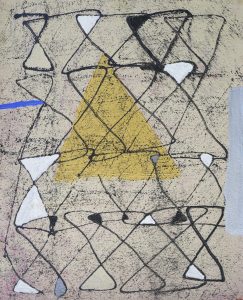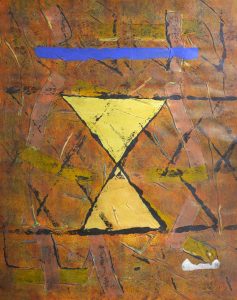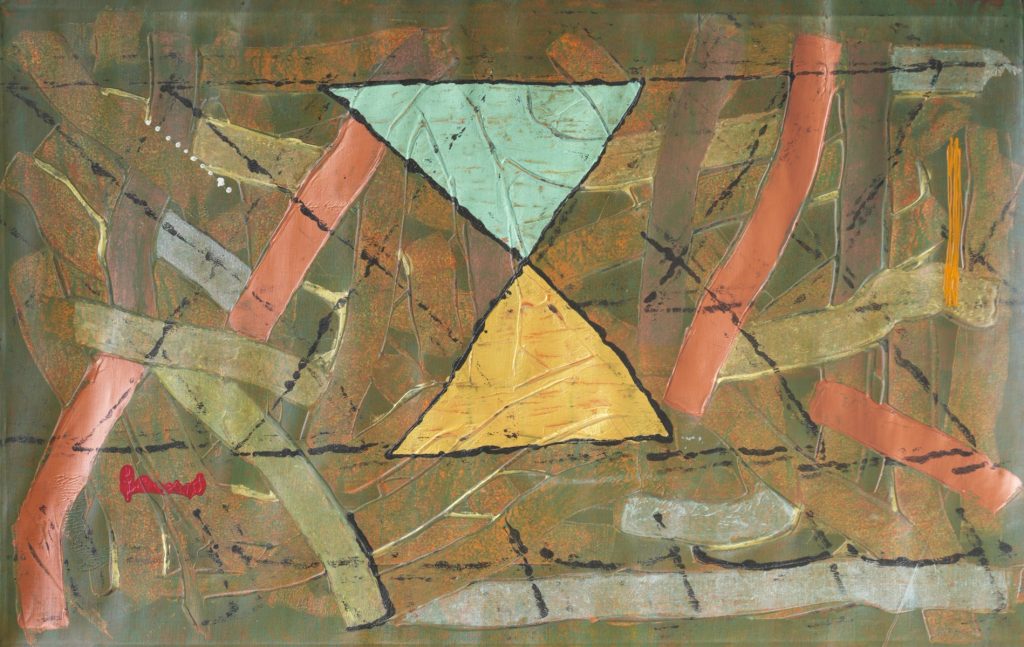Ved Prakash Bhardwaj
S Harshvardhan, who has taken a different approach to abstraction in contemporary Indian art, currently has a solo exhibition titled Serene i.e. calm or Nirmal at Art Alive Gallery in Delhi. The title is taken from Thomas Gray’s poem Elegy in a Country Churchyard:
Full many a gem of purest ray serene
The dark unfathom’d caves of ocean bear:
Full many a flower is born to blush unseen,
And waste its sweetness on the desert air.
Serene (Nirmal or pure) is not just a word, it is also a feeling. Harshvardhan creates this feeling or we can say that he searches for this pure feeling in his paintings. This discovery inspires him to paint a poem of colours on canvas like a poet, using triangles as the main character.

Harshvardhan’s paintings like poetry have many shades of meaning. Like a poem, standing in front of a painting gives the impression of entering a world that is not yet fully open. The words guide us through the poem and its various contexts. This guidance is provided by the geometric shapes, textures, and, in some places, thick and curved lines in Harshvardhan’s paintings. In his paintings, he repeats the triangle shape in the same way that a singer repeats a note or a line, or that certain syllables in a poem are repeated continuously.
At a time when life is becoming more complex than ever, Harshavardhan’s art emerges as a pure stream of emotions and feelings. Art feels like a breath of fresh air in the midst of material pressures and technological communication complications. Harshvardhan’s abstract paintings appear to convey a message of peace through their colour palette.
Abstraction does not occur only at the level of form. The form can be found in a variety of structures, such as the human body, natural elements, or geometrical shapes. Any form’s semantic configuration is limited, and it prevents the observer from going beyond the form’s boundaries. As a result, abstraction should only be viewed emotionally. Form and gestures are two ways that emotion can be supported. A picture without a human figure cannot be correctly described; how to understand the gestures in it remains a mystery. One possible answer is that emotions can be understood through the artist’s use of colours or other forms that are not associated with a specific person or thing. Only in this way can the abstraction be grasped. Any viewer who is only attracted to surface-level shapes and colours will not comprehend the depth of abstraction. Abstract images, for him, become a challenge from which the average viewer prefers to flee. This challenge, to understand them, to experience the emotions and ecstasy that the artist has created in a different way, remains constant in Harshvardhan’s paintings as well.

The colours in Harshavardhan’s paintings are not very bright. Although metallic colours are used in many of his paintings, the colours he usually uses are made up of two or more colours. This combination of colours creates a kind of harmony between them. They transform into a lyrical chorus of singers.That’s why the mind remains completely calm while looking at his paintings. Anxiety is not the nature of his paintings. He also states that “for me, colour is always relative to the signature of my creation, I see it in relation to the colours it is surrounded by.” That’s why the colours are never lonely here; they are mutually dependent on each other and appear as a unit. This interdependence of colours creates an implicit social context. That is why the colours in his paintings appear to create an emotional atmosphere. As a result, we cannot see colours solely as colours in his paintings. The colours in his paintings seem to support each other, as well as talk to each other.
In the paintings included in this exhibition, he has used thick texture in many places and thick patches in some places. All this makes these paintings mysterious. These patches or thick lines in the whole structure of the painting first stop the viewer and then provoke them to read me and understand who I am or what I can be. From here his paintings begin a journey of thought and emotion with the viewer. The paintings go as far as the viewer can go. In this work, the texture in his paintings is helpful. When he works in several layers, the second color peeping from behind one creates a different attraction.

The presence of a triangle in the art of Harshvardhan has special significance. In Indian art, the triangle is most commonly used in Warli painting. Harshavardhan also uses the method of Warli painting to create a form by combining two triangles, but in its pure form. He does not use them to make human figures. In this way, he makes tribal art contemporary by giving it a new context. The use of a triangle is also found in the art of his father Jagdish Swaminathan but it was in a completely different way. Single triangle is rarely used in the paintings of Harshvardhan. In most of the paintings, they come in the form of a couple, which symbolizes the vibrancy of the relationship. To make the liveliness of the relationship more effective, he uses different colours in both triangles as if two people of different natures or characters are meeting. If the audience wants, they can also be seen as male and female. Sometimes with these triangles, he uses wavy or flying lines as if a festival is going on the canvas. This creates the illusion of movement even in a still picture and makes the picture more alive. These lines sometimes appear like a design that evokes memories.
In his paintings, Harshavardhan sometimes used patches of colours in the border area or made some unknown designs. This gives the illusion of moving the picture on two levels. One is the movement in the centre of the picture that continues through the triangle and the other is the movement on the edges. There is an association between this two-level dynamic. Here again Warli painting is remembered, which often has a tradition of marking the picture apart from the centre. We can also see this in miniature paintings, in which sometimes designs are made around the picture. This method is seen in many folk arts. This structure is symbolic in the art of Harshavardhana. Whatever he creates on the edges of the picture is minimal. It is not decorative like miniatures and folk paintings but is the basis for the expansion of meaning.






